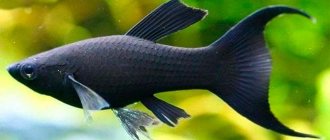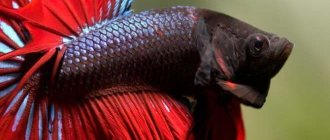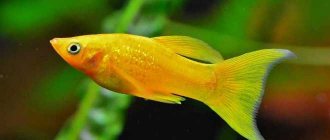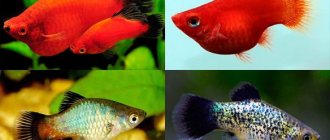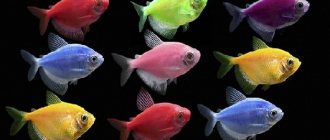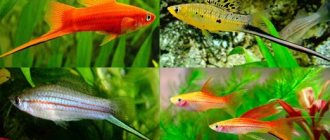Black molly (Poecilia sphenops, Mollienesia sphenops) is a very common aquarium fish from the poeciliaceae family. It is difficult to confuse it with other representatives of viviparous fish - the calling card of the fish is the coal-black, velvety-like coloring of the body and fins.
In a large aquarium with varied vegetation and mangrove driftwood, the black beauties swimming steadily and looking simply magnificent.
Description
Valued for its unusual color, ability to reproduce in a community aquarium, and livability.
Appearance
The body is elliptical, elongated. Laterally compressed. The mouth is large, oriented upward. The color of the body and fins is velvety black. Aquarists consider the presence of light spots to be a defect.
The latest achievement of breeders is the tail fin of the black molly in the shape of a rotated letter “Ω”. The ends are pointed. There are varieties with the dorsal fin extended towards the tail.
Males grow up to 50–60 mm, females – up to 60–80 mm.
Lifestyle
They are mobile in all areas of the aquarium and playful. Males are especially active. In an overcrowded tank and when there is a shortage of females, they are aggressive towards their relatives and defend the territory. Keep at a rate of 2 females to 1 male.
The situation is similar with a lack of food. Only females show aggression.
In nature, they are schooling fish. In captivity, gregariousness is less pronounced.
Lifespan
The black molly fish lives 3–3.5 years.
Natural habitat
Wild molly sphenops is significantly different in color from what we are used to seeing in aquariums. Its color is dominated by silver-gray colors, sometimes brownish or olive. Small black spots are randomly scattered throughout the body. The size of the fish is small - maximum 12cm.
It is distributed in brackish and fresh water bodies of Central America from Mexico to Colombia. There are also small populations on the islands of the Caribbean.
Sphenops appeared in aquariums at the end of the 19th century, but it was possible to obtain offspring from them in captivity only in 1910 in Germany. Everyone's favorite black hybrid, or black molly, was bred by American aquarist Bill Sternke in 1936. The fish came to Russia 12 years later.
Content
Black mollies are considered an unpretentious fish, but they are more demanding than other types of platies in terms of living conditions. Sensitive to temperature conditions. Prefers hard, clean water. Air purging is desirable, filtration is required.
Provide a lighted swimming area in the center of the container. Place shelters in the form of plants or stones, snags, grottoes.
Don't keep molly alone. The ideal option is 1 male for 3 females. Reduces male hostility.
Aquarium size
Provide a spacious aquarium: from 15 liters per couple in a common aquarium. From 50 liters when keeping a flock of 3 individuals separately. Mollies do not tolerate acidic environments.
Water parameters
- Water temperature: 23–28° When the temperature drops below 21°C, they are little active and do not grow. The color fades.
- Hardness: 5–20 °F.
- Acidity: pH 7.5–8.5.
If acceptable for other inhabitants, mix in sea salt: 2–4 grams per liter (2–4‰). A heaped teaspoon contains 10 g, without it - 7 g. Other inhabitants will not like the saltiness.
To maintain acidity standards, change 1/4 of the water volume weekly. Old water becomes acidic.
Plants
Mollies tend to eat soft plant foliage. Give preference to greens with rough leaves.
- Vallisneria can withstand salinity up to 20‰.
- Stiffleaf arrowhead (sagittarium).
- Java moss is a ready refuge for fry.
- Riccia grows faster than it can be eaten.
- Elodea floats in the water column or is fixed. They won’t have time to eat it: it will grow back and will have to be cut.
- Indian fern (water cabbage).
Fry and females hide in dense thickets during spawning.
Priming
Doesn't matter. But black molly looks good against a light background.
Decorative elements and driftwood serve as a refuge for fish. Females rest behind them from the activity of males.
Treat snags with caution. Incorrectly prepared, lower pH.
Optional equipment
- Compressor with sprayer. Air blowing will be needed in an overcrowded aquarium and when there is a lack of plants. The productivity for aeration is from 0.8 liters of air per hour per 1 liter of water.
- An internal filter is suitable for containers up to 150 liters. With connection to a compressor. Otherwise - external. Pumping capacity is required from 8 volumes per hour. The current created is familiar to mollies.
- Siphon for cleaning the bottom from food debris and waste.
- Heater equipped with a thermostat. For large aquariums, a submersible horizontal ground one is convenient. Does not need to be turned off when changing water.
- Thermometer.
- Scraper for removing algae from front glass. There is no need to clean the back and sides if there are no decorations. Black molly eats green growths with pleasure.
- Net with frame from 4".
Lighting
The backlight is bright, the luminous flux is 80–100 lumens per liter. Choose LED and fluorescent light sources with a color temperature of 5000 K. The lamps are energy saving. The aquarium does not heat up.
Daylight hours are 11–13 hours.
Aquarists recommend 2-3 hours of natural light and sunlight per day. The benefits of “tanning” are not justified. But algae infestation is guaranteed. Some of the parasites will be eaten by mollies. But not all types of unwanted vegetation cannot cope with the rapid growth of weeds.
The active growth of algae is provoked by ultraviolet radiation and the presence of nitrites and ammonia in the water.
Reviews
Yellow mollies, according to aquarists, decorate the tank with their color. They are not picky about living conditions. But difficulties arise during reproduction.
Feeding
Black molly is an omnivorous fish. Relatives in nature feed more on plant food. Aquarium hybrids need a varied diet.
Feed 1-2 times daily. In addition to the mandatory fasting day.
Live food
Bloodworms and tubifex are high in calories and contain essential substances and vitamins. Regular eating causes obesity. They are mined at the bottom of standing reservoirs. There is a risk of introducing parasites and infections, and fish poisoning.
The coretra is not so dangerous because it lives and feeds in the water column. Not as nutritious.
Daphnia, gammarus and brine shrimp are bred at home. Experienced aquarists solve the problem of the safety of live food in this way. Nauplii, Artemia larvae, are used to feed the fry.
- Live food contains nutrients and beneficial substances in a form accessible to fish.
- Uneaten, does not spoil water.
- Caught in dirty waters is dangerous.
Frozen food
Safe against infections and parasites. Even products from trusted manufacturers poison fish. During storage and delivery, there is a possibility of defrosting, which is unacceptable.
- Contains the same ingredients as live food.
- It is necessary to siphon off the remains.
- Risks poisoning.
Dry food
It is produced in the form of powders, flakes and tablets. The food is balanced and contains vitamins, micro- and macroelements. Manufacturers:
- Hikari;
- Zoomworld;
- Tropical;
- Aller Aqua;
- TETRA;
- SERA;
- JBL.
If you are leaving, install an automatic feeder with a timer.
- No preparation required.
- Contains the necessary ingredients.
- Safe.
- The presence of the owner is not required.
- Residues must be removed.
Plant food
- Black mollies need plant fiber. Plant food makes up 30% of the diet.
- Spirulina tablets and flakes. Spirulina is a cross between a bacterium and an algae. This makes the composition specific. Not enough fiber (9-11%). The vitamins, micro- and macroelements contained will strengthen the immune system. Blanched vegetables - cucumber, zucchini, cabbage. Spinach and greens will do. Dried nettle is rich in vitamins.
- Crushed and blanched oat flakes (“Hercules”), semolina.
Top dressing
Used to diversify the diet. Feed with hard-boiled chicken egg yolk. Chopped boiled meat, liver. Chopped sea fish. Raw river fish should not be given due to the presence of parasites and infections.
General recommendations
- None of the listed foods are suitable for constant feeding. Diversify your diet.
- A lack of plant food in the diet will affect the condition of the plants. The black molly will eat the algae and attack the grass.
- Overfeeding threatens gastrointestinal disorders and obesity. Don't forget about fasting days.
- Remove uneaten food. It spoils the water and provokes the growth of algae.
Mollies what to feed
Molly fry are fed frozen or dry food from well-known manufacturers, which must be crushed before feeding. Frozen food, defrost to room temperature.
Remember that fish are gluttonous, so it is necessary to include vegetarian food in the diet or set aside diet days with minimal food consumption.
The tank must have green spaces: algae with soft leaves, mosses rich in fiber, which the molly can eat on its own. Adults need to be fed once a day, and fry – 2-3 times.
Reference! To enhance the color of fish, feed containing carotenoids is used.
Compatibility
Black mollies get along with a variety of neighbors. Large predators, catfish, are contraindicated. The skin of goldfish is covered with mucus, which the mollies eat along with their scales and fins. Males conflict with tiger barbs.
Keeping with other platies is not recommended. Due to cross insemination.
They live harmoniously with all viviparous animals.
Who do mollies get along with in an aquarium and how to distinguish a female from a male?
Representatives of this species are peaceful and do not conflict with other aquarium fish. They need the same quiet neighbors who will not chase them, much less eat them.
The following are considered good neighbors for molly: Guppies; catfish; Pecilia; Danio and Swordtail. Also, Mollies will not be harmed by Cockerels; Angelfish; Gourami; Labeo; Tetras.
The maturation of Mollies is a rather long process. Puberty in females occurs much earlier - after 6 months, and in males even longer - closer to 10-12 months. The main difference between individuals is the anal fin.
In boys it is represented by the gonopodium. It is cone-shaped, narrow and long. The genital organ of female mollies is rounded in the shape of a triangle. Female mollies are much more massive and larger than males, 10 centimeters long, but this also depends on the species. Another distinctive feature is an active lifestyle.
Reproduction
Occurs without stimulation under recommended conditions. Molly is a viviparous fish. Black molly fry are active from the moment of birth and hide from adults. Reproduction in a community aquarium is acceptable. They will survive healthy and with a reaction.
For breeding, pregnant mollies are placed in an internal spawning tank or a separate container.
How to distinguish a male from a female
Females are larger than males, the anal fin is triangular. The male has a fin in the form of a gonopodium, a thin tube for fertilizing eggs in the female’s abdomen.
Gender change
Female mollies change sex. Before childbirth, after childbirth. Age doesn't matter. The reason is unknown. Typical for platies.
Spawning
In mollies this occurs continuously. The male pursues females, actively moving his gonopodium. Pregnancy is determined by a swollen abdomen. The first pregnancy lasts 30–40 days.
2-3 days before birth, the abdomen “squares up”. Place the fish ready for marking in a container with an abundance of plants. Greenery and mosses will serve as shelter for the fry. Females eat the fry right during birth.
For the first time, up to 50 fry are born. An adult fish brings up to 200. After giving birth, the female is returned to the general aquarium.
The male's seed is retained. A pair of births without a male is possible. A breeder's nightmare.
It is not recommended to keep fry in a cramped indoor spawning tank. They develop poorly and are not afraid of large fish.
Change 1/3 of the water 3-4 times a week.
Feed the fry “live dust”, nauplii. Pet stores sell powdered food for juveniles. Grinded adult dry food is suitable. Plant food - phytoplankton, ground oatmeal. Get phytoplankton yourself by exposing a jar of water to sunlight for a couple of days. When it blooms, add it to the vessel with the fry. Feed with egg yolk and egg powder rubbed through a fine mesh net.
Approaching birth
The approaching birth of offspring can be noticed if you pay attention to the abdominal cavity. It changes from a round appearance to a slightly square shape.
To preserve the offspring, it is necessary to place the mother and babies in an aquarium for spawning, where a lot of living vegetation is needed, in which the fry usually hide.
The water change in the spawning tank should be 20-30% daily. If you have a filter and air, changes can be made every other day.
A mother who has given birth, like her offspring, needs nutritious food, preferably live food. Remains of food should be removed from the aquarium with the fry. Rarely, dark-skinned parents can give birth to albino children who are completely white. More often, as they grow, they begin to acquire a dark tint, and already in the first 3-4 weeks, dark spots appear on the body of the fry; subsequently they increase in size and darken. But they still don’t become purely dark. Raised albinos may have medium grayish or rainbow spots on their body.
Diseases
Black mollies are prone to disease. Before starting treatment, carry out tests and check the water parameters. Control the content of nitrates, nitrites, ammonia.
Contagious diseases
Ichthyophthiriasis (“semolina”) manifests itself as white spots-growths on the scales and fins. Caused by ciliate parasites. Treatment:
- Super Ick Cure from Aquarium Pharmaceuticals.
- Faunomor from Aquarium Munster.
- Sera Costapur.
- Ichthyophorus from “Zoomir” (in difficult cases).
Proceed in accordance with the attached instructions.
Oodiniosis (“gold dust”) is similar to semolina, but the spots are golden in color. Infection with skin parasites. It is treated with JBL Oodinol according to the instructions.
Salt baths with potassium permanganate help with parasitic and fungal diseases. Ichthyophthiriasis will not be cured.
- Prepare 2 separate vessels with a solution of potassium permanganate (“potassium permanganate”). Pink colour. Capacity - from 5 l.
- Add salt to the first at the rate of 30 g/l, to the second - 60 g/l. Stir and equalize the temperature with the aquarium temperature.
- Transfer the fish to the first container for 15 minutes.
- Swish in the second container in a net for about 1 minute to remove parasites.
- Place the mollies in the aquarium. Repeat the procedure daily for 3 days.
Cold
Occurs when water cools suddenly. Symptoms: lack of appetite, inactive, swimming near the surface.
Restore the recommended thermal conditions.
Poisoning
Oxygen poisoning is an excess of oxygen content. It occurs due to the replacement of unsettled water and excessive air ventilation of a planted aquarium. Symptoms: restless behavior, darkening of the gills.
Chlorine poisoning occurs when replacing unsettled chlorinated water. Symptoms: rotation around the longitudinal axis, attempts to jump out. Treatment: place the sick person in settled water, perform intensive air ventilation of the vessel.
Ammonia poisoning. Reasons: contamination of the bottom or filter with organic matter. Symptoms: active inappropriate behavior, seizures. Lying on the ground with open mouth and gills. Treatment: transplant into a container with settled water in another aquarium. Replace water, remove contaminants.
Classification problems
The scientific taxonomy of mollies is complex and controversial. The fact is that animal taxonomy does not stand still: with the discovery of new species and rethinking of the data obtained, the classification sometimes changes, and quite radically.
When the new fish were discovered at the end of the 19th century and brought to Europe in 1907, they were assigned to the genus Mollienesia. Today, this generic name has been abolished, and the fish have been assigned to the genus Poecilia. In Russian, the old generic name has been preserved and continues to be actively used in everyday speech by amateur aquarists.
For quite a long time, only varieties with melanistic characteristics, that is, colored in dark, almost black colors with a blue tint, were classified as mollies. However, over time, the name spread to other representatives of the genus.
Other fish, previously known as “platypecilia,” are scientifically classified in the genus Xiphophorus, that is, they are relatives of swordtails.
Spreading
The natural habitat of mollies is Central America, or more precisely, the southern regions of Mexico and Guatemala. Most of the rivers flowing in these countries are characterized by moderate speed in their lower reaches and flow into the Atlantic Ocean.
The water here is predominantly fresh, but with some salt, which comes with ocean water flowing into the mouths during high tides.
The vegetation along the banks and in reservoirs is abundant, but the water is not particularly clean. But the sun shines almost all year round and generously heats the reservoirs in which small, nimble fish swim.
Very few species of mollies live in the wild. Most of the fish that go on sale are hybrids and artificially obtained populations, including the most famous black molly.
